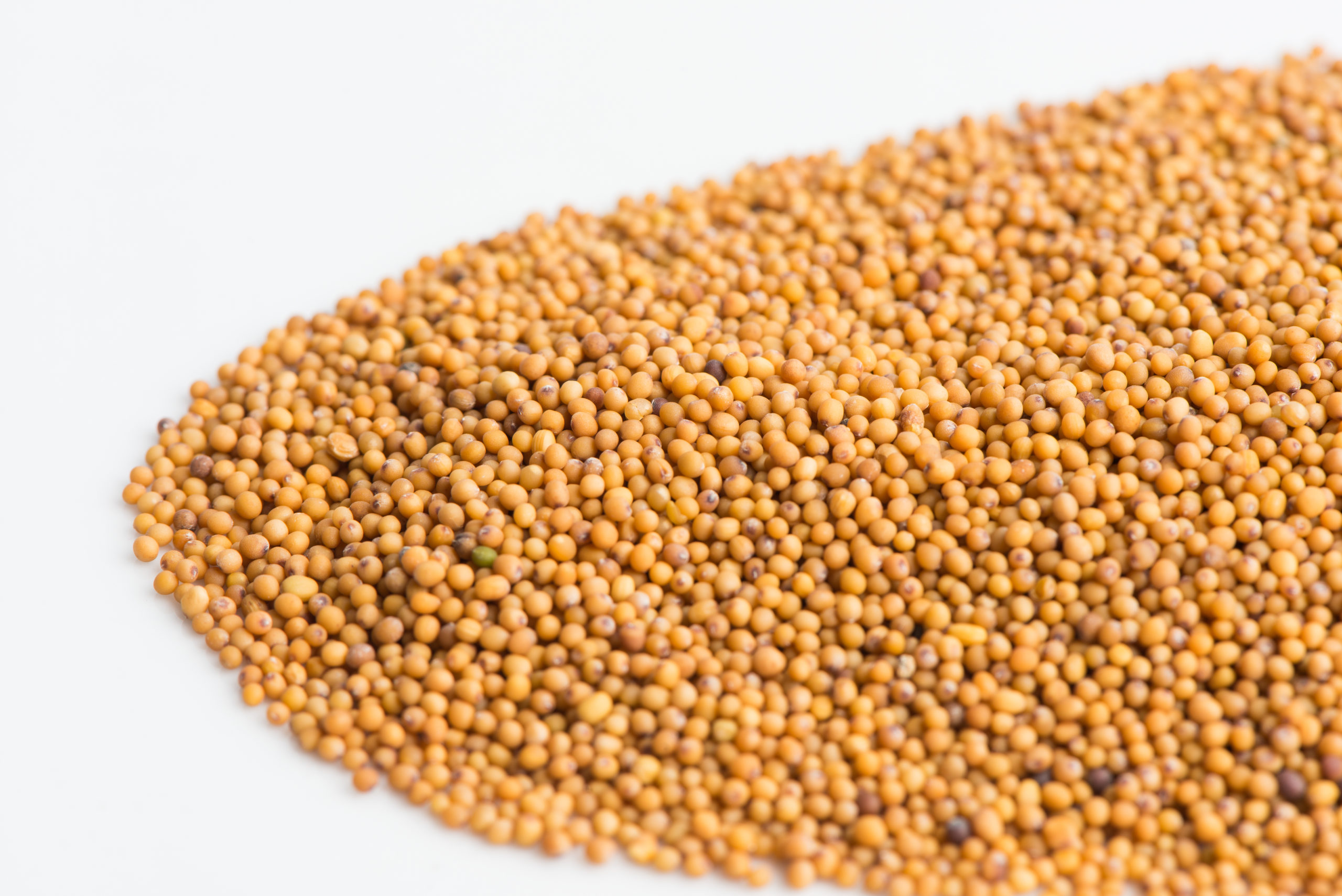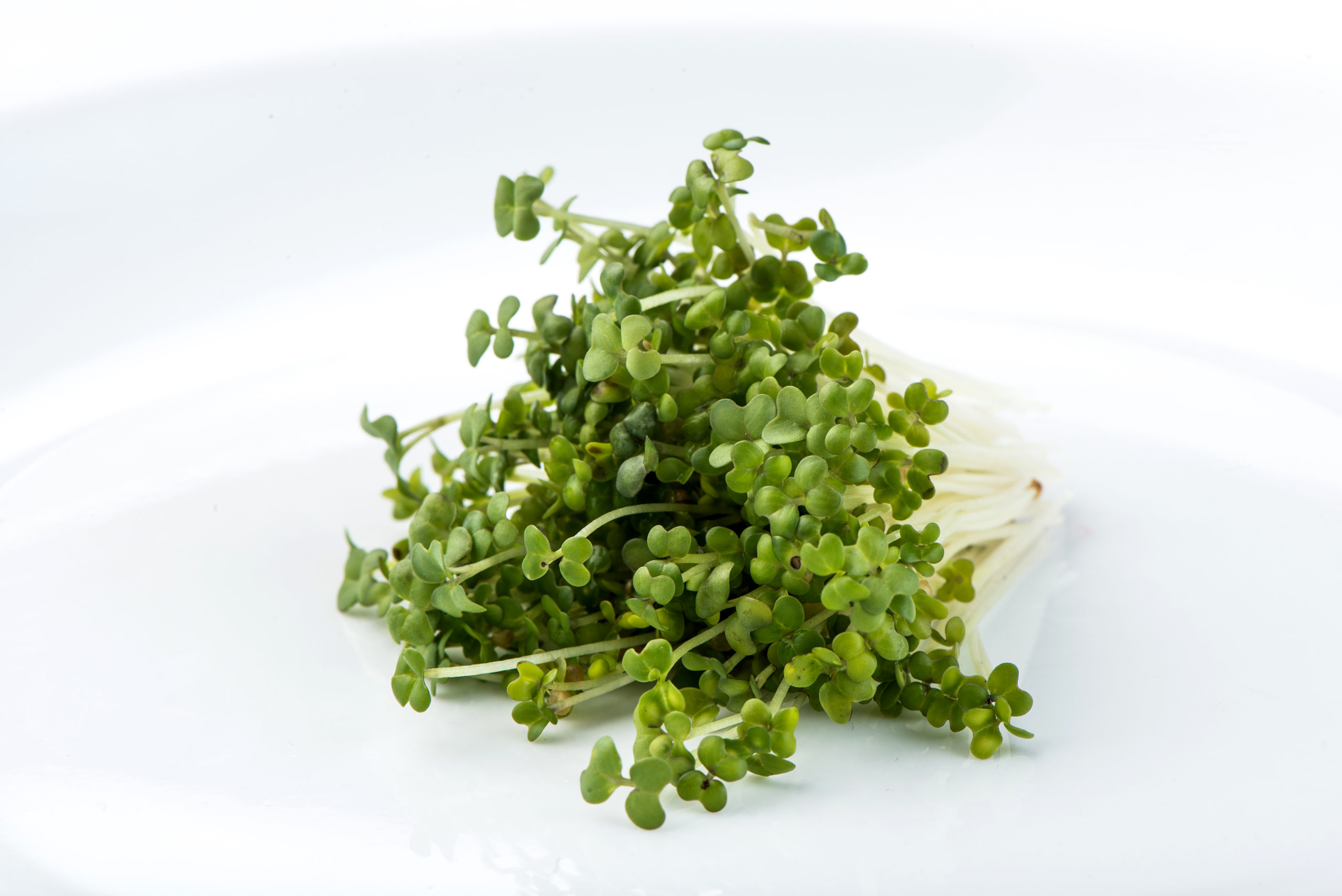Grow as a sprout or microgreen. Hot, but a nice addition to sandwiches or salads.
- Days to Sprout: Sprout- 4-5, Microgreen 10- 12
- Soak Time: 1-2 hours
- Yield: 1 tbsp of dry seed yields approx. 1-2 cups of sprouts.
- Storage: Our seeds should sprout well for a year after you purchase them, if stored in a cool dry place. If you’d like to extend the germination life of your seeds, store them in the fridge. If you store your seeds in the freezer, they’ll last even longer!
Sprouting Directions
Soak: Put 1-2 Tbsp. seed in a wide mouth jar with a sprouting lid. Add water, swirl, and drain. Refill jar with water and soak 1-2 hours. (Soaking broccoli for longer than 2 hours can cause it to lose germination.) Drain well and invert jar at an angle on a sprouting rack, or in a bowl or drain rack.
TIP: After draining, tap the shake the jar gently to remove excess moisture. Rotate the jar and tap gently a few more times.
Rinse: Twice a day, refill jar with cold water, swirl, and drain well by tapping excess water from jar.
Enjoy! Ready to eat in 5 days. Refrigerate to store. (Sprouts store best when they are fairly dry. If you need to store immediately after rinsing, spin dry first.)
Helpful tips:
- Some sprouts tend to clump together as they grow. To separate, fill the jar with water, remove the screen and stir gently with a fork during the regular rinse. Remove hulls if desired. Drain well as usual.
- The drier they are the better sprouts keep. Be sure to let sprouts grow another half day after the final sorting rinse before storing in the fridge. Optional: put folded paper towel on top of the sprouts in the jar. Put lid on and refrigerate turned upside down. This removes excess moisture.
- If your home is very warm during the summer months, it may help to rinse the sprouts three times a day with cold water. Stir gently if clumping.
- To remove the hulls and unsprouted seeds from leafy sprouts, use a special sorting rinse. Pull sprouts out of the jar into a large bowl filled with water. Swish gently using fingers to separate the tangled roots. Most hulls will separate and rise or sink. Discard the hulls. Collect the sprouts back to the jar with or without aid of a strainer. Return the sprouting closure and drain so you can continue for half a day more of sprouting.
- Some brassicas (cabbage family) like radish and broccoli develop very fuzzy root hairs the longer you leave them undisturbed and these can be mistaken for mould. You will even see these after a few days of storage in the fridge. Stirring and rinsing removes the root hairs for a time.
Grow Microgreens!
Soilless Method (broccoli, mustard)
Soak. Using a tray with drainage holes, rinse enough seed to cover the bottom of the tray. Soak the seed for 1-2 hours. Use a jar with a sprouting lid for soaking if the tray holes are too large. Drain, rinse and drain holding at an angle to remove excess water. Spread the seed evenly on the bottom of the tray and cover with a lid top and bottom or put in plastic bag.
Rinse. Rinse with cold water twice a day, using either a gentle flow from a tap, dipping in a sink, or spraying. Drain thoroughly.
Grow. The roots will form a mat from which the microgreens will emerge. At that point, put in indirect sunlight, florescent/LED lights or grow lights. The watering is then easy: fill the container 1 cm deep with water and allow to sit for a few seconds in the water and then tilt on an angle to decant the water until only some moisture is remaining remaining in the root area. Continue to rinse twice a day as described above.
Harvest!
Typically, microgreens grown without soil are harvested at 7-10 days. Harvest before the next expected rinse so the shoots are dry. Harvest before the next expected rinse so the shoots are dry. Harvest microgreens using scissors or knife.
Instead of harvesting all at once, you can start to harvest microgreens as soon as the first two leaves are spread out. Take only what you need for your meal and allow the rest to keep growing or put the tray in the fridge loosely covered and a plastic bag or dome to harvest another day.
The Buddha stated that if an individual were to pick a single mustard seed every hundred years from a seven-mile cube worth of mustard seeds, then by the time the last seed is picked, the age of the world cycle would still continue.
Grow Microgreens!
Soil Method (small seed)
You will need:
• 10” x 20” gardening trays (1-inch-tall preferred), 1 with
holes + 1 without. Smaller microgreen trays also work well.
• Good quality organic starting soil mix
• Parchment paper or unbleached paper towel (optional).
• Dome lids (clear or black) or plastic sheet
• Organic seed
• Mister bottle, cup measures, garden spray nozzle (optional)
• Scissors or sharp knife
1. Don’t soak small or medium size seed. Small seed such as broccoli and arugula are easier to sprinkle on top of the soil if they are not soaked.
2. Prepare Soil
Add water to top of the bag (or each tray) 12 hours ahead of use until almost fully hydrated. Rehydrate the bag as necessary. If you were to put the soil in your hand and squeeze it, you should not be able to get much more than a drop of water out of it for the perfect moisture content. If you want to mist the seed after putting it on the soil, reduce the water hydration of the bagged soil a bit.
TIP: To check for overwatering, tip the tray to one end. Water should not pool enough to drip out of the tray.
3. Fill Trays with Soil
Use a tray with holes. Fill with 3/4-1.5” of soil. The closer to the top of the tray the better aid to air circulation. Use a block or your hand to smooth and flatten the soil without compacting it. The back of a tablespoon or spatula smooths out the valleys. You can wait to put the tray without holes under until after unstacking/uncovering or add it to the bottom now.
TIP: Place a layer or two of paper towel on the bottom of the tray before adding soil for easier cleanup.
4. Sow the Seed
Sprinkle the seed evenly over the soil in the tray (pizza cheese shaker, spoon). The seeding density depends on the stage at which you’re planning to harvest. For small seeds for 1-week microgreens, start with approximately 15 -28 grams (1.5 – 2 Tbsp). Sow slightly less seed for 2-3 week microgreens.
Seeds do not need misting if the soil has enough moisture. Mist if you need more moisture. Use a spray bottle or a garden spray nozzle set to light mist. The soil should be moist throughout, but not soaking wet.
5. Cover the Seed
Doing away with soil as a seed cover decreases the work and time it takes to grow the greens. If stacking the trays on top of each other, use a cover directly on the seed like parchment paper, a plastic sheet or wet unbleached paper towel layer. When not stacking trays, the seed will need protection from drying out by using a dome/lid. Use a clear dome or an inverted 10 x 20” tray without holes. For smaller trays, use several layers of unbleached paper towels folded onto itself with or without a plastic sheet covering the top.
TIP: Most microgreens will grow taller when you keep the light out at the beginning, but this may make the stem weaker. Most seeds germinate in the light no problem.
6. Stack Trays or Cover with Lids
Stacking helps to quickly force the roots into the soil, provides darkness, promotes even germination/growth. Stack 2-5 filled trays on top of each other with an empty tray on the top of the stack with a weight in it. Check at least once a day to see if the trays need water. Cabbage family seed sprouts quickly, so stack for 2-3 days. Others stack 3-5 days.
If choosing not to stack, simply cover the trays with clear or black-out plastic, a lid or dome. Check at least once a day to see if the trays need water. Cover for the same number of days as above.
7. Expose to Indirect Sunlight, Florescent/LED or Grow Lights.
After 2-5 days, the microgreens should be ready for light. If the microgreens begin to get quite tall and leggy, this is an indication that they may need a bit more light.
8. Water the Growing Microgreens
Check the seed once or twice daily and water as needed. The soil should be moist, not wet. Once trays are unstacked, add water from below into the no holes tray as necessary.
9. Harvest!
Microgreens are harvested at 1-3 weeks with scissors or a sharp knife. Make sure microgreens are not damp before storing. If needed, you may use a small fan or salad spinner to dry the microgreens before storing in a sealed container in the fridge.
Instead of harvesting all at once, you can start to harvest microgreens as soon as the first two leaves are spread out. Take only what you need for your meal and allow the rest to keep growing or put the tray in the fridge loosely covered and a plastic bag or dome to harvest another day. Water as necessary.
10. Enjoy!
Microgreens make everything better, so have fun with them and add them to your favourite dishes!
Helpful tips:
• To moisten your bag of soil, add water ahead until almost fully hydrated.
• The roots grow under the soil so it works well to water from below if the tray has holes in it, or open the side of the tray and pour water beside the soil when using flexible plastic trays. Otherwise misting or watering from the top works well too.



Kimberly –
I haven’t had any luck sprouting these ones. They go off” almost immediately and never sprout.”
littleCatalyst –
Great quality mustard seeds! Sprout fantastically!!! Great taste!!
Beat Hegnauer –
I like the Wasabi Mustard because it is an easy Micro Green to grow and it tastes amazing. It germinates well and you have a good looking and tasting Micro Green within 8 to 10 days. I’m using Urban Cultivators.
Shera –
this is difficult to grow, it requires extra steps. it will rot easier than any other sprout I’ve grown. I have a stacking sprout kit and this one needs to be on the top tier and I tip the container to make certain it drains completely …. do not let it sit in water
Jon# –
Spicy salad version of the popular sushi paste. One of my favourites! Excellent germination.
AmmyS –
The seeds that we got were amazing, they grew so quickly and impressively. The process is very easy and it is a no-fail system with these seeds that we got. Great service. Very quick turn around time. Cannot be happier.
Alen –
Over 95% germination rate. Very easy to grow. Can refrigerate for 5 days. I used a plastic tray sprouter and it worked very well. The sprouts are crunchy, juice and spicy. Can be eaten by itself or better mixed in a salad.
Melanie –
It is suppose to be easy to grow, but it never grows. After 4 days it barely has germiantion, and was close to be rotten. I have no problem to grow sandwich booster or lentil crunch.
Dawn –
These seeds swell up faster than any others, but don’t seem to turn into long sprouts. I am on my second batch, I had to throw out the first because it became skunky. I will continue to experiment.
Moses –
Perfect germination rate. High quality seeds and amazing flavour.
Judy –
Seeds were small and easy to soak but hard to keep back in the jar but they did sprout fast and were tasty but a bit strong. Great for use a topping on top of avocado on toast.
Jonny –
Great flavor, but for a mustard its little more finnicky, likes its ideal temps and humidity to germinate and for micro greens it does well with airflow. Love this stuff!
Suntwist –
I currently am growing these for a microgreen, however they don’t grow so well for long term. Germination rate is great 95% for sure, as a sprout they would be great but I need to order some mizuna, better for microgreen.
Witty Peasant –
Lite and spicey, great on a sandwich! Easy to grow on Baby Blanket.
Chickadee –
I got an excellent results microgreening these. I germinate them in the dark. They think” they are underground and grow tall looking for the sun. On day 4 – 5 I take them out and give them 16 hrs of “sun” (grow light) and 8 hrs of dark. Within 4 – 5 days they are ready to harvest. The greens are spicy – I love it.”
Elaine –
These have a wonderful wasabi taste to them however they are very slow compared to other sprouts – after 8 days still only half the size of say clover that has sprouted for 5 days.
Elaine –
Very tasty but extremely low germination rate, slow to grow and tiny. I will not buy them again. Wish I could try the Mizuma or Red mustard but 1 kg is far too much, particularly after this experience.
Trek –
Totally satisfied although it doesn’t taste as strong as I expected, I made a mustard like paste with my first batch, can be used in a million ways,
Leonardo –
The wasabi mustard is very tasty and after doing my homework on how to prevent dampening off I have had no problem growing full and healthy crops. I love this stuff on everything.
Langford microgreens –
these seeds arrived on time and in good simple packaging. However, after three attempts to grow them on microgreen trays they always develop white mold. None of my other seeds are affected by mold or any other problems.
Cyberclaude –
The Mustard wasabi is a sprout that is best used in sandwich or as a topping over a cream cheese appetizer, it a gives a fresh tangy taste to every meal when served as a side dish.
10922749 Canada Ltd –
We have been a business client for at least 4 years and have used many of their microgreen seeds for our local indoor microgreens farm.The quality of their seeds is great. These Oriental wasabi seeds is great and germination is amazing as always. We prefer these mustard seeds over the yellow mustard seeds.They are very similar but we get higher yields on our trays with this variety and we prefer this particular flavour. Theyre very spicy and we love it! We’re grateful to have a great seed vendor available in Canada. We believe it’s great to support local businesses and the environment at the same time. Thanks you, we grately appreciate you!